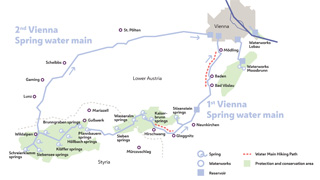The First Vienna Spring Water Main - A History of Vienna's Water Supply
In 1864, the Vienna City Council voted the construction of the First Vienna Spring Water Main, which to this day covers approximately 40 percent of Vienna's water requirements. It was planned by the geologist and City Council member Eduard Suess and implemented under Mayor Cajetan Felder. The main was to safeguard adequate drinking water supply even for the suburbs and to improve its quality, thereby excluding any further health hazards for the population.
Inauguration in 1873
After a construction period of only three years, the First Vienna Spring Water Main was inaugurated on 24 October 1873 by Emperor Francis Joseph I concurrently with the Hochstrahlbrunnen Fountain in Schwarzenbergplatz. The pipeline is 120 kilometres long, cost 16 million Gulden to build and soon became a symbol of Vienna’s liberation from water shortages and dangers of epidemics. In residential buildings, the formerly used domestic wells were gradually replaced by communal water taps. In 1888, over 90 percent of residential buildings situated within Vienna’s (then) municipal territory were already connected to the new main.
The tapping of Pfannbauern Spring
In 1965, the entire Rax-Schneeberg-Schneealpe Massif was declared a water protection zone. As of December 1988, the Pfannbauern Spring (which originates in Aschbach Valley on the federal road to Mariazell) was added to the existing spring resources and introduced into the network of the First Vienna Spring Water Main. Since the addition of this spring to the network, it is possible – under normal conditions – to supply all of Vienna with mountain spring water.
The Second Main
City of Vienna | Vienna Water
Contact form

